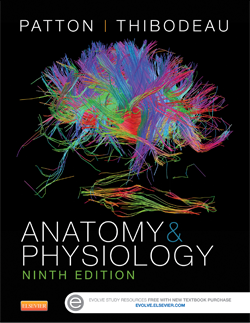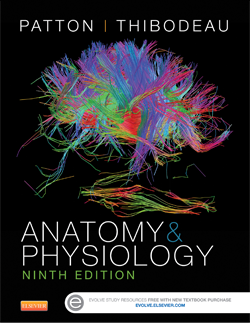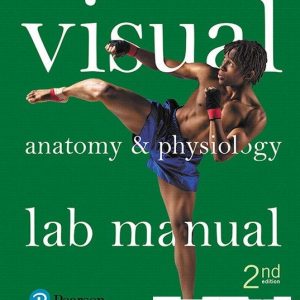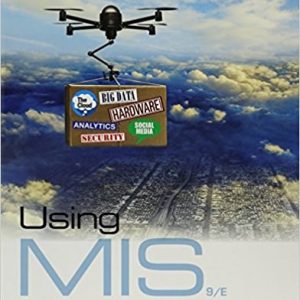This is completed downloadable of Test Bank for Anatomy and Physiology 9th Edition by Patton

Product Details:
- ISBN-10 : 0323298834
- ISBN-13 : 978-0323298834
- Author:
No other two-semester A&P text rivals Anatomy & Physiology, 9th Edition for its student-friendly writing, visually engaging content, and wide range of teaching and learning support. Focusing on the unifying themes of structure and function and homeostasis, authors Patton and Thibodeau utilize a very conversational and easy-to-follow narrative to guide you through difficult A&P material. Readers can also connect with the textbook through a number of free electronic resources, including Netter’s 3D Interactive Anatomy, A&P Online, an electronic coloring book, online tutoring, and more! Just because the subject matter of A&P is complicated, doesn’t mean your textbook has to be ― especially when you have Patton at your side!
Table of Content:
- 1. Organization of the body
- Science and society
- Anatomy and physiology
- Language of science and medicine
- Characteristics of life
- Levels of organization
- Anatomical position
- Body cavities
- Body regions
- Terms used in describing body structure
- Body planes and sections
- Interaction of structure and function
- Chapter summary
- Review questions
- Critical thinking questions
- 2. Homeostasis
- Homeostasis
- Homeostatic control mechanisms
- Levels of homeostatic control
- Summary of homeostasis
- Chapter summary
- Review questions
- Critical thinking questions
- 3. Chemical basis of life
- Units of matter
- Atomic structure
- Attractions between atoms
- Attractions between molecules
- Chemical reactions
- Metabolism
- Organic and inorganic compounds
- Inorganic molecules
- Chapter summary
- Review questions
- Critical thinking questions
- 4. Biomolecules
- Organic molecules
- Carbohydrates
- Lipids
- Proteins
- Nucleic acids and related molecules
- Combined forms
- Chapter summary
- Review questions
- Critical thinking questions
- 5. Cell structure
- Functional anatomy of cells
- Cell membranes
- Cytoplasm and organelles
- Nucleus
- Cytoskeleton
- Cell connections
- Chapter summary
- Review questions
- Critical thinking questions
- 6. Cell function
- Movement of substances through cell membranes
- Cell metabolism
- Chapter summary
- Review questions
- Critical thinking questions
- 7. Cell growth and development
- Protein synthesis
- Cell growth
- Cell reproduction
- Regulating the cell life cycle
- Chapter summary
- Review questions
- Critical thinking questions
- 8. Introduction to tissues
- Introduction to tissues
- Extracellular matrix
- Tissue repair
- Body membranes
- Chapter summary
- Critical thinking questions
- Review questions
- 9. Tissue types
- Epithelial tissue
- Connective tissue
- Muscle tissue
- Nervous tissue
- Chapter summary
- Review questions
- Critical thinking questions
- Introduction
- 10. Skin
- Structure of the skin
- Hypodermis
- Skin color
- Functions of the skin
- Appendages of the skin
- Chapter summary
- Review questions
- Critical thinking questions
- 11. Skeletal tissues
- Functions of bone
- Types of bones
- Bone tissue
- Microscopic structure of bone
- Bone marrow
- Regulation of blood calcium levels
- Development of bone
- Bone remodeling
- Repair of bone fractures
- Cartilage
- Chapter summary
- Review questions
- Critical thinking questions
- 12. Axial skeleton
- Divisions of the skeleton
- Skull
- Hyoid bone
- Vertebral column
- Thorax
- Chapter summary
- Review questions
- Critical thinking questions
- 13. Appendicular skeleton
- Upper extremity
- Lower extremity
- Skeletal differences between men and women
- Chapter summary
- Critical thinking questions
- Review questions
- 14. Articulations
- Classification of joints
- Representative synovial joints
- Movement at synovial joints
- Chapter summary
- Review questions
- Critical thinking questions
- 15. Axial muscles
- Skeletal muscle structure
- How muscles are named
- Axial muscles
- Muscles of the head and neck
- Trunk muscles
- Chapter summary
- Review questions
- Critical thinking questions
- 16. Appendicular muscles
- Appendicular muscles
- Upper extremity muscles
- Lower extremity muscles
- Posture
- Chapter summary
- Review questions
- Critical thinking questions
- 17. Muscle contraction
- General functions
- Function of skeletal muscle tissue
- Function of skeletal muscle organs
- Graded strength principle
- Function of cardiac and smooth muscle tissue
- Introduction
- General functions
- Function of skeletal muscle tissue
- Function of skeletal muscle organs
- Graded strength principle
- The big picture: Muscle tissue and the whole body
- Review questions
- Critical thinking questions
- Introduction
- 18. Nervous system cells
- Organization of the nervous system
- Glia
- Neurons
- Reflex arc
- Nerves and tracts
- Repair of nerve fibers
- Chapter summary
- Review questions
- Critical thinking questions
- 19. Nerve signaling
- Electrical nature of neurons
- Action potentials
- Synaptic transmission
- Neurotransmitters
- Neural networks
- Chapter summary
- Review questions
- Critical thinking questions
- 20. Central nervous system
- Coverings of the brain and spinal cord
- Cerebrospinal fluid
- Spinal cord
- Brain
- Somatic sensory pathways in the central nervous system
- Somatic motor pathways in the central nervous system
- Chapter summary
- Review questions
- Critical thinking questions
- 21. Peripheral nervous system
- Spinal nerves
- Cranial nerves
- Somatic motor nervous system
- Chapter summary
- Review questions
- Critical thinking questions
- 22. Autonomic nervous system
- Overview of the autonomic nervous system
- Structure of the autonomic nervous system
- Autonomic neurotransmitters and receptors
- Functions of the autonomic nervous system
- Chapter summary
- Review questions
- Critical thinking questions
- 23. General senses
- Sensory receptors
- Classification of receptors
- Sense of pain
- Sense of temperature
- Sense of touch
- Sense of proprioception
- Chapter summary
- Critical thinking questions
- Review questions
- 24. Special senses
- Sense of smell
- Sense of taste
- Senses of hearing and balance
- Sense of vision
- Review questions
- Critical thinking questions
- 25. Endocrine regulation
- Organization of the endocrine system
- Classification of hormones
- How hormones work
- Eicosanoids
- Chapter summary
- Review questions
- Critical thinking questions
- 26. Endocrine glands
- Pituitary gland
- Pineal gland
- Thyroid gland
- Parathyroid glands
- Adrenal glands
- Pancreatic islets
- Gonads
- Placenta
- Thymus
- Gastric and intestinal mucosa
- Heart
- Adipose tissue
- Other endocrine glands and hormones
- Chapter summary
- Critical thinking questions
- Review questions
- Introduction
- 27. Blood
- Composition of blood
- Blood plasma
- Red blood cells
- White blood cells
- Platelets
- Hemostasis
- Chapter summary
- Review questions
- Critical thinking questions
- 28. Heart
- Heart structure
- The heart as a pump
- Chapter summary
- Review questions
- Critical thinking questions
- 29. Blood vessels
- Blood vessel types
- Circulatory routes
- Systemic circulation
- Fetal circulation
- Chapter summary
- Review questions
- Critical thinking questions
- 30. Circulation of blood
- Hemodynamics
- Primary principle of circulation
- Arterial blood pressure
- Venous return to the heart
- Measuring blood pressure
- Minute volume of blood
- Velocity of blood flow
- Pulse
- Chapter summary
- Review questions
- Critical thinking questions
- 31. Lymphatic system
- Overview of the lymphatic system
- Lymph and interstitial fluid
- Lymphatic vessels
- Circulation of lymph
- Lymph nodes
- Lymphatic drainage of the breast
- Tonsils
- Thymus
- Spleen
- Chapter summary
- Review questions
- Critical thinking questions
- 32. Innate immunity
- Organization of the immune system
- Species resistance
- Mechanical and chemical barriers
- Inflammation and fever
- Phagocytosis
- Natural killer cells
- Interferon
- Complement
- Toll-like receptors
- Chapter summary
- Review questions
- Critical thinking questions
- 33. Adaptive immunity
- Overview of adaptive immunity
- B cells and antibody-mediated immunity
- T cells and cell-mediated immunity
- Types of adaptive immunity
- Summary of adaptive immunity
- Chapter summary
- Review questions
- Critical thinking questions
- 34. Stress
- Selye’s concept of stress
- Some current concepts about stress
- Chapter summary
- Review questions
- Critical thinking questions
- Introduction
- 35. Respiratory tract
- Structural plan of the respiratory tract
- Upper respiratory tract
- Lower respiratory tract
- Chapter summary
- Review questions
- Critical thinking questions
- 36. Ventilation
- Respiratory physiology
- Mechanism of ventilation
- Pulmonary volumes and capacities
- Pulmonary airflow
- Ventilation and perfusion
- Regulation of ventilation
- Chapter summary
- Review questions
- Critical thinking questions
- 37. Gas exchange and transport
- Pulmonary gas exchange
- How blood transports gases
- Systemic gas exchange
- Chapter summary
- Review questions
- Critical thinking questions
- 38. Upper digestive tract
- Organization of the digestive system
- Mouth
- Pharynx
- Esophagus
- Stomach
- Chapter summary
- Review questions
- Critical thinking questions
- 39. Lower digestive tract
- Small intestine
- Large intestine
- Vermiform appendix
- Peritoneum
- Liver
- Gallbladder
- Pancreas
- Chapter summary
- Review questions
- Critical thinking questions
- 40. Digestion and absorption
- Overview of digestive function
- Digestion
- Secretion
- Control of digestive gland secretion
- Absorption
- Elimination
- Chapter summary
- Review questions
- Critical thinking questions
- 41. Nutrition and metabolism
- Overview of nutrition and metabolism
- Carbohydrates
- Lipids
- Proteins
- Vitamins and minerals
- Metabolic rates
- Mechanisms for regulating food intake
- Chapter summary
- Review questions
- Critical thinking questions
- 42. Urinary system
- Anatomy of the urinary system
- Physiology of the urinary system
- Chapter summary
- Review questions
- Critical thinking questions
- 43. Fluid and electrolyte balance
- Interrelationship of fluid and electrolyte balance
- Total body water
- Body fluid compartments
- Chemical content, distribution, and measurement of electrolytes in body fluids
- Avenues by which water enters and leaves the body
- Some general principles about fluid balance
- Mechanisms that maintain homeostasis of total fluid volume
- Regulation of water and electrolyte levels in plasma and interstitial fluid
- Regulation of water and electrolyte levels in ICF
- Regulation of sodium and potassium levels in body fluids
- Chapter summary
- Review questions
- Critical thinking questions
- 44. Acid-base balance
- Mechanisms that control pH of body fluids
- Buffer mechanisms for controlling pH of body fluids
- Respiratory mechanisms of pH control
- Urinary mechanisms that control pH
- Chapter summary
- Critical thinking questions
- Review questions
- Introduction
- 45. Male reproductive system
- Sexual reproduction
- Male reproductive organs
- Testes
- Reproductive ducts
- Accessory reproductive glands
- Supporting structures
- Composition and course of seminal fluid
- Male fertility
- Chapter summary
- Critical thinking questions
- Review questions
- 46. Female reproductive system
- Overview of the female reproductive system
- Ovaries
- Uterus
- Uterine tubes
- Vagina
- Vulva
- Female reproductive cycles
- Breasts
- Chapter summary
- Review questions
- Critical thinking questions
- 47. Growth and development
- A new human life
- Prenatal period
- Birth, or parturition
- Postnatal period
- Effects of aging
- Causes of death
- Chapter summary
- Review questions
- Critical thinking questions
- 48. Genetics and heredity
- The science of genetics
- Chromosomes and genes
- Gene expression
- Medical genetics
- Prevention and treatment of genetic diseases
- Chapter summary
- Review questions
- Critical thinking questions
- Glossary of Anatomy & Physiology
- Index
- A&P connect
- Anatomical directions





